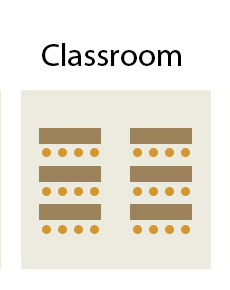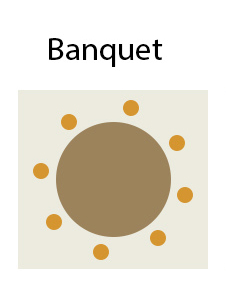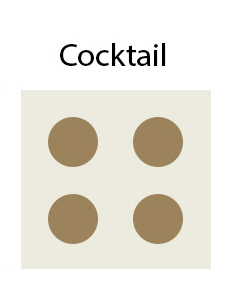One of the most important factors that should be paid attention to is the arrangement of seats for the audience in the conference hall. You can arrange the chairs you have in different ways and decorate your hall according to the type and size of the hall and the number of participants, but you should keep in mind that any type of seminar or conference is a type of arrangement. He demands something special and there are certain principles with small details that must be followed. In this regard, in the following, we have introduced some examples of the most common styles of seating arrangements in conference halls.
1-Cinematic style arrangement
First of all, we must say that this style is one of the most flexible room arrangement designs. As you can see in the picture, all the seats are arranged in rows parallel to each other and behind each other. These rows can be arranged in a circular, semi-circular, flat or at an angle towards the focal point, i.e. In such a way that all the audience sit facing the main platform and in front of the presenter or speaker. This design is mostly used for very formal meetings that have a question and answer mode. The main thing about this style is that the chairs should be placed in such a way that people don’t have to walk behind each other to see the screen or the speaker. If you use party chairs, keep the distance between the rows so that people can move comfortably, this distance should be about 60 cm and the distance between each chair and the back seat should be between 7 and 15 cm. In this design, there is no news of the table in front of the audience. A theater-style setting is more efficient for events where attendees are just the audience and catering is not part of the conference program.
Advantages: It is very suitable for conferences where the audience does not need to write and read, and it usually has a capacity of more than 40 people.
Disadvantages: When the number of participants is very large, you will need a hall where the rows have a different level from each other so that the last rows can see the podium, lack of a table for taking notes and writing, low interaction between the audience.

2- U-shaped arrangement
In this model, the tables are arranged in a way to form the letter U in the English language, and the chairs are placed around the tables in such a way that there are only seats on the outer sides of the letter U. This style of layout is mostly used for board meetings or group discussions where there is a speaker or screen in the center and facing the audience. This layout style is mostly used for press conferences, training classes and collaboration sessions or brainstorming workshops. The important point of this type of arrangement is to pay attention to the number of participants, which should not exceed 25 people, because if the number of participants increases, the two sides of the letter U should be raised, and as a result, people sitting in the same row cannot see each other. and the participation and interaction of people with each other will decrease.
Pros: Good and sufficient working space for the speaker, good interaction between the participants with each other and with the presenter, very ideal for events that require audio visual equipment and speakers.
Disadvantages: There is a limit on the number of contacts

3- Classroom-style arrangement
As you can see in the picture, in this style, the rows of tables and chairs are arranged side by side and parallel to the speaker or screen, the tables are usually in three rows, and two chairs are placed behind each table. In this design, the audience can easily write and take notes due to the presence of the table. This arrangement is very suitable for meetings where the audience needs to use books, notebooks or laptops. It is interesting to know that this model is the most convenient type of arrangement for very long meetings and snacks and catering equipment are easily available to the audience. The point here is to respect the distance between the rows so that people can move easily, the minimum distance between each seat and the side seat is approximately 5 cm. Also, the tables should be arranged in the right angle with the podium.
Advantages: the presenter can easily see all his people and contacts, more contacts can attend the event.
Disadvantages: Participants will only see each other’s backs and the amount of interaction will be minimal.

4- Layout in the style of the boardroom (rectangular table)
In this model, a rectangular table is placed in the center of the hall and chairs are arranged around it. As its name suggests, this arrangement plan is very suitable for board meetings, and it is also more common to use this type of arrangement in counseling and training sessions, open group discussions, and interviews. Sometimes, if an oval or rectangular table is not available, by placing several regular tables together, they create rectangles, squares, or empty squares. Remember that the bigger the size of your table, the harder it is for your audience to see each other, especially those sitting in the same row may not be able to see the people at the end of their row, so the number of seats should not be less than 12 and maximum 15. Increase the number.
Pros: Good working environment, high interaction between participants and very good working atmosphere
Disadvantages: It is not suitable for large groups, it is not ideal for events that require a speaker or audio visual equipment.

5- Arrangement in the form of empty shapes
The design of the conference table in this model is such that the tables are arranged side by side to create geometric shapes such as square, rectangle or even octagon and their center remains empty. This arrangement is very suitable for groups between 12 and 30 people where the interaction between the group of participants is very important and there is no need for a screen or a speaker. Because it creates a suitable work space for everyone, and there is a lot of visual communication between people.

6- Banquet arrangement
In this style, six to ten chairs sit around a round, square or hexagonal table, and the reason for using this style is to facilitate meal service. Of course, in most events, chairs are arranged mostly on one side of the table or so-called half a round, so that all people are facing the podium (just like what you see in the picture). This arrangement is more used for events where meals are served or small business meetings that require high interaction.


